The role of the press in India has been instrumental in shaping political and social movements, especially during the struggle for independence. From the Civil Disobedience Movement to World War II and beyond, various acts and ordinances were introduced to control and suppress the press. This included the Indian Press (Emergency Powers) Act of 1931, stringent wartime measures, and post-independence regulations like the Press (Objectionable Matters) Act of 1951. These laws highlight the ongoing tension between maintaining national security and ensuring freedom of expression.
Evolution of Press Legislation in India: From Colonial Controls to Democratic Reforms
Press Act during Civil Disobedience Movement
- Political Landscape: The political landscape in the 1930s underwent a significant transformation, marked by Mahatma Gandhi’s launch of the civil disobedience movement.
- Press Ordinance of 1930: In response to these developments, the Indian government introduced a fresh Press Ordinance in 1930, designed to “provide for the better control of the Press.”
- Revival of the Press Act of 1910: This ordinance essentially revived the provisions of the Press Act of 1910.
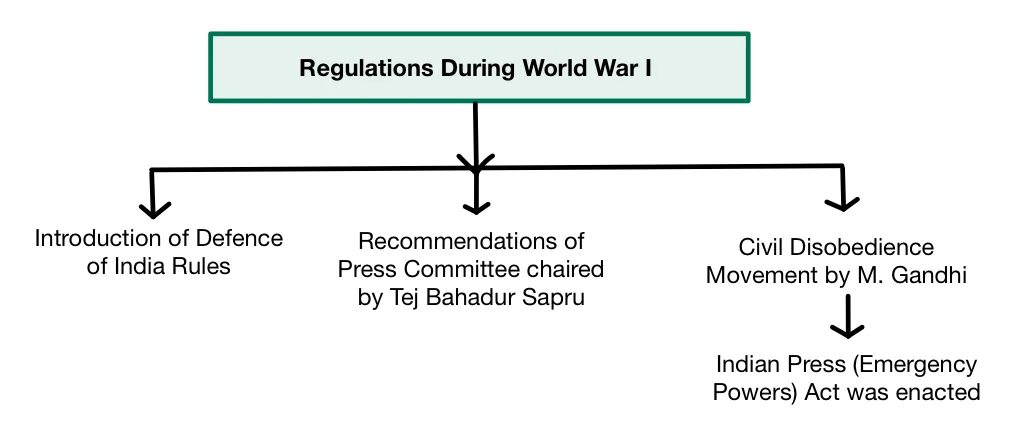
Enroll now for UPSC Online Course
The Indian Press(Emergency Powers) Act,1931
- Enactment of the Indian Press (Emergency Powers) Act, 1931: Subsequently, in 1931, the government enacted the Indian Press (Emergency Powers) Act, which bestowed extensive powers upon provincial governments to suppress the propagation of the civil disobedience movement.
- Provisions of the Indian Press (Emergency Powers) Act, 1931
- Section 4(1) of the Indian Press (Emergency Powers) Act, 1931: Incited, encouraged, or tended to incite or encourage the commission of offenses such as murder or any cognizable offense involving violence.
- Directly or indirectly expressed approval or admiration of such offenses or individuals, whether real or fictitious, who were alleged or represented to have committed such offenses.
- Expansion of the Press Act through the Criminal Amendment Act, 1932: In 1932, the Press Act of 1931 was further expanded through the Criminal Amendment Act of 1932.
-
- Section 4 was made comprehensive, encompassing a wide range of activities calculated to undermine the government’s authority.
Press Act During the Second World War
During the Defence of India Rules, the British colonial government implemented stringent measures to suppress political agitation and control information. A key measure was pre-censorship, which significantly impacted press freedom and the flow of information.
- Pre-Censorship: Under the Defence of India Rules, the British government enforced pre-censorship of newspapers and publications. This meant that all content, including articles, news reports, and editorials, had to be submitted to government authorities for approval before publication.
- This pre-censorship mechanism allowed the government to control the narrative and ensure that nothing critical of British rule or supportive of nationalist movements was allowed to be published.
- It gave the authorities the power to suppress any information they deemed harmful to their interests.
- Press Emergency Act: The Press Emergency Act of 1910, which was re-enacted during this period, played a crucial role in reinforcing press restrictions.
- The Act empowered local governments to demand significant financial security from printers and publishers, which could be forfeited if the newspaper published what the government considered “objectionable material”.
- The Act also allowed the government to annul the declaration of registration for an offending newspaper, effectively shutting it down.
- The threat of financial penalties and closures acted as a deterrent against independent reporting and critical journalism.
- Official Secrets Act: The Official Secrets Act was another instrument used by the colonial authorities to maintain secrecy and control over information.
- This act prohibited the disclosure of official secrets and any information that the government deemed sensitive.
- Journalists and publishers could be penalized for publishing information that the government classified as confidential, further restricting the freedom of the press.
- Ban on Congress Activity: One of the most extreme measures taken during this period was the complete ban on the publication of news related to Congress activity.
- The Indian National Congress was a prominent political organization that played a central role in the struggle for Indian independence.
- By prohibiting the reporting of its activities, the government aimed to prevent the spread of nationalist ideas and suppress public support for the Congress and its leaders.
- Extensive Powers under the Defence of India Act: During the Second World War, which lasted from 1939 to 1945, the executive branch of the government exercised extensive powers under the Defence of India Act.
- Reinforcement of Pre-Censorship Measures: Pre-censorship measures were reinforced, and amendments were made to the Press Emergency Act and the Official Secrets Act.
- At one point, the publication of all news related to Congress’s activities was declared illegal.
- End of Wartime Powers and Shift in Press Regulation: These special powers assumed by the government during the wartime period ceased in 1945, marking a significant shift in the regulatory landscape concerning the press.
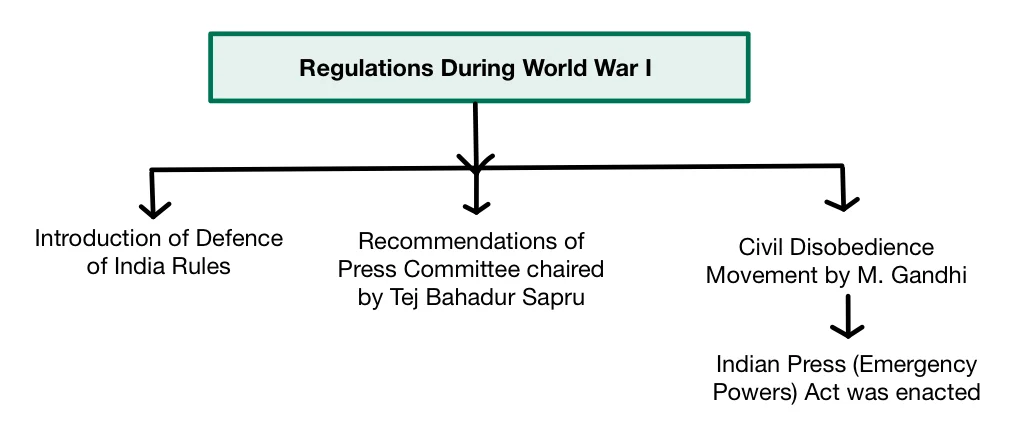
The Press Enquiry Committee During 1947
- Role of the Press Enquiry Committee (1947): The Press Enquiry Committee of March 1947 held a pivotal role in assessing and reevaluating press laws in the context of the fundamental rights outlined by the Constituent Assembly of India.
- Appointment and Purpose of the Committee: This committee was appointed by the Government of India to examine existing regulations and provide recommendations to align them with the evolving democratic principles and rights as enshrined in the Indian Constitution.
Some of the key recommendations put forward by the Committee included
- Repealing the Indian Emergency Powers Act of 1931: The Committee recommended the abolition of this act, which had granted extensive powers to provincial governments to suppress propaganda associated with various political movements.
- This repeal signified a move towards eliminating emergency measures to restrict civil liberties and freedom of expression.
- Amendments in the Press and Registration of Books Act: The Committee suggested modifications to the existing Press and Registration of Books Act, aiming to align it with the changing political landscape and the need for greater press freedom.
- Modification of Sections 124-A and 153-A of the Indian Penal Code: These sections were often used to suppress dissent and criticism of the government.
- The Committee’s recommendation aimed to alter these sections to safeguard freedom of expression and minimize the misuse of these provisions.
- Repealing the Indian States (Protection against Disaffection) Act, 1932, and the Indian States (Protection) Act, 1934: These acts were aimed at maintaining order and control within princely states.
- The Committee’s recommendation for their repeal indicated a commitment to democratic principles and the removal of legal instruments that could potentially infringe on press freedom.
- Adapt to Changing Political Landscape: The recommendations of the Press Enquiry Committee underscored the government’s willingness to adapt to a changing political landscape and acknowledge the importance of a free and responsible press in a democratic India.
- Press Freedom and Fundamental Rights: These suggestions aimed to promote greater press freedom, uphold fundamental rights, and ensure that laws aligned with democratic principles as India transitioned into a newly independent nation.
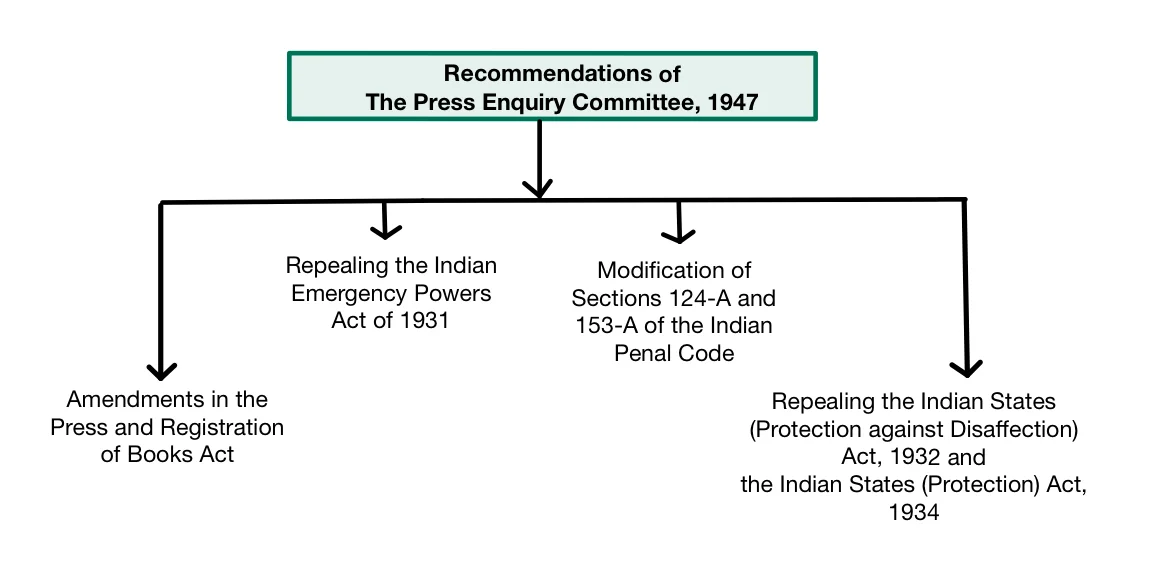
Impacts of Press on National Movement
The impact of the press on the Indian national movement was multifaceted and played a crucial role in various aspects of the struggle for independence.
- Economic Critique of Colonialism: The press played a pivotal role in presenting a critical analysis of British economic policies in India.
- It highlighted the actual economic conditions of the country and fueled anti-British sentiments.
- Example: Naoroji’s “Poverty and Un-British Rule in India” introduced the Drain of Wealth theory, while R.C. Dutt’s “Economic History of India” thoroughly examined the economic record of colonial rule since 1757.
- Education and Information Dissemination: Both vernacular and Anglo-Indian press publications educated the masses by reporting on local, national, and international events.
- They served as a vital source of information and provided the ideological basis for revolts and the mobilization of public opinion.
- The “Hindoo Patriot” by H. C. Mukherji, for instance, actively exposed the oppression of indigo planters in Bengal, contributing to the nationalist cause.
- Political Awakening: The press became a platform for diverse viewpoints and debates, fostering intellectual and ideological development within the independence movement.
- It also facilitated the expression of grievances and the articulation of demands for self-governance, ultimately leading to the formation and promotion of various political organizations.
- Promotion of National Consciousness: The press provided a means for national leaders to communicate with the masses and mobilize them for the struggle for independence. It fostered a sense of national unity and purpose.
- Example: during the Non-Cooperation Movement of the 1920s, the press was instrumental in disseminating Gandhi’s messages and mobilizing supporters for the cause.
- Spearheading Socio-Religious Movements: Indian press publications played a significant role in promoting reformist ideas by engaging in debates on issues such as female infanticide, widowhood, child marriage, prostitution, untouchability, and superstitions.
- They actively contributed to socio-religious movements aimed at addressing these social issues.
The Press (Objectionable Matters) Act, 1951
- Amendment to Article 19(2): Following the adoption of the new Indian Constitution in January 1950, the government found it necessary to seek an amendment to Article 19(2) of the Constitution and subsequently enacted the Press (Objectionable Matters) Act in 1951.
- Comprehensive Regulatory Framework: This new Act represented a more comprehensive regulatory framework compared to any earlier press-related legislation.
- Replacement of Earlier Press Legislation: It effectively replaced the Central and State Press Acts that had been in operation until that time.
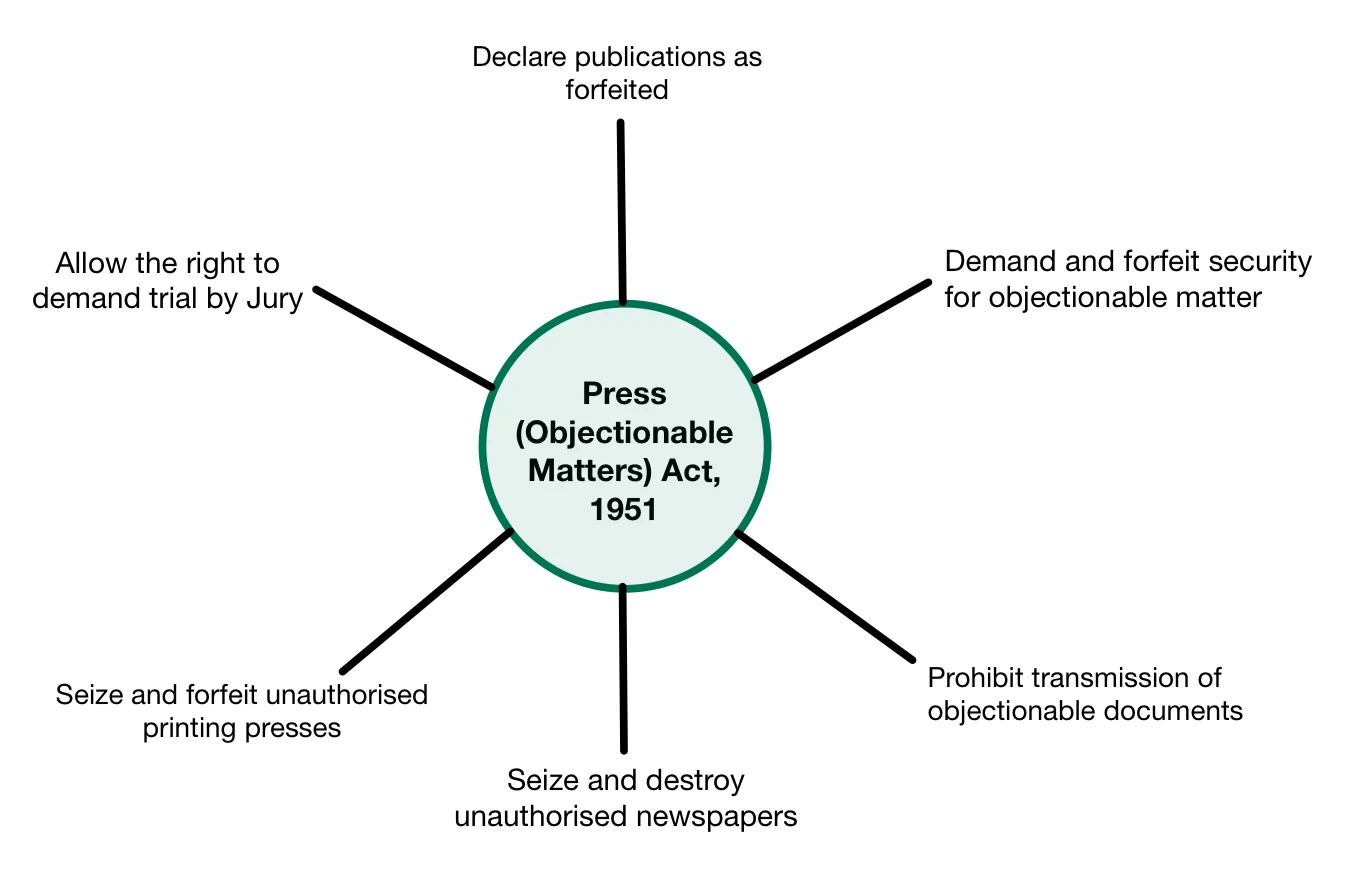
The Press (Objectionable Matters) Act of 1951 granted the government the authority to
- Demand and forfeit security from printing presses and newspapers for the publication of “objectionable matter.”
- Declare certain publications as forfeited.
- Prohibit the transmission of objectionable documents by post.
- Seize and destroy unauthorized newspapers.
- Seize and forfeit unauthorized printing presses.
- Allow the aggrieved owners of newspapers and printing presses the right to demand trial by jury.
- Duration and Opposition to the Act: This Act remained in effect until 1956.
- However, it was met with opposition from the All-India Newspapers Editors Conference and the Indian Federation of Working Journalists.
- Call for Inquiry into the Functioning of the Indian Press: They called on the government to conduct a comprehensive inquiry into the functioning of the Indian press.
Press Commission, 1952
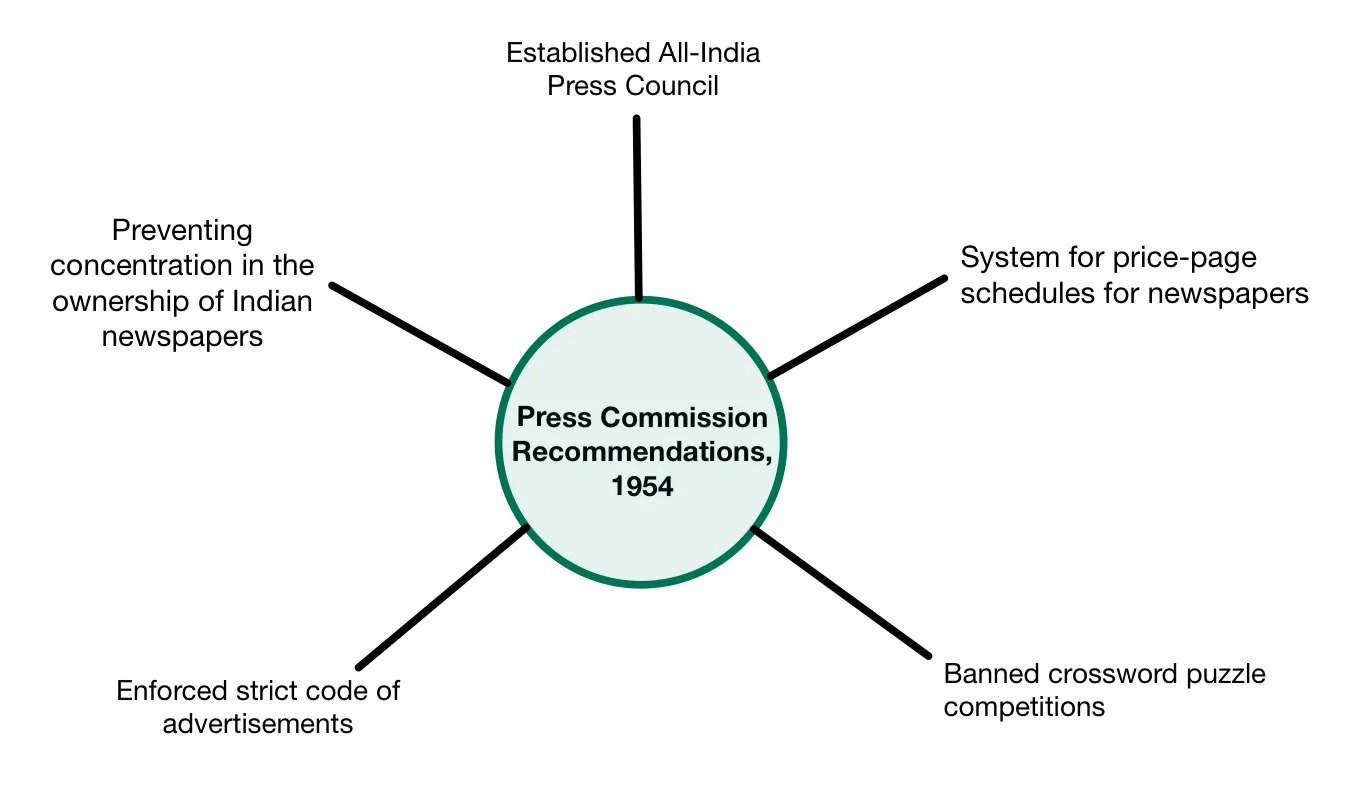
- Appointment of the Press Commission in 1952: The government of India appointed the Press Commission in 1952, under the leadership of Sir Justice G.S. Rajadhyaksha.
- Key Recommendations of the Press Commission Report (1954): The commission submitted its report in August 1954, which included various recommendations, such as:
- The establishment of an All-India Press Council.
- The implementation of a system for price-page schedules for newspapers.
- Banning crossword puzzle competitions.
- Enforcing a strict code of advertisements by newspapers.
- Highlighting the importance of preventing concentration in the ownership of Indian newspapers.
- Subsequent Legislative Developments Affecting the Press: In recent years, the Central Government has also passed several other acts related to newspapers and publications, including the Delivery of Books and Newspapers (Public Libraries) Act, 1954;
- The Working Journalists (Conditions of Service) and Miscellaneous Provisions Act, 1955; The Newspaper (Price and Page) Act, 1956;
- The Parliamentary Proceedings (Protection of Publications) Act, 1960, among others.
- These laws have collectively shaped the regulatory landscape surrounding the Indian press.
Enroll now for UPSC Online Course
| Must Read | |
| Current Affairs | Editorial Analysis |
| Upsc Notes | Upsc Blogs |
| NCERT Notes | Free Main Answer Writing |
Conclusion
The evolution of press laws in India highlights the ongoing struggle to balance freedom of expression with national security.
- From the suppression during the Civil Disobedience Movement and World War II to post-independence regulatory frameworks, the press has played a vital role in shaping public opinion and promoting national consciousness.
- As India continues to evolve as a democracy, ensuring a free and responsible press remains a fundamental challenge and necessity.
Sign up for the PWOnlyIAS Online Course by Physics Wallah and start your journey to IAS success today!

 GS Foundation
GS Foundation Optional Course
Optional Course Combo Courses
Combo Courses Degree Program
Degree Program











